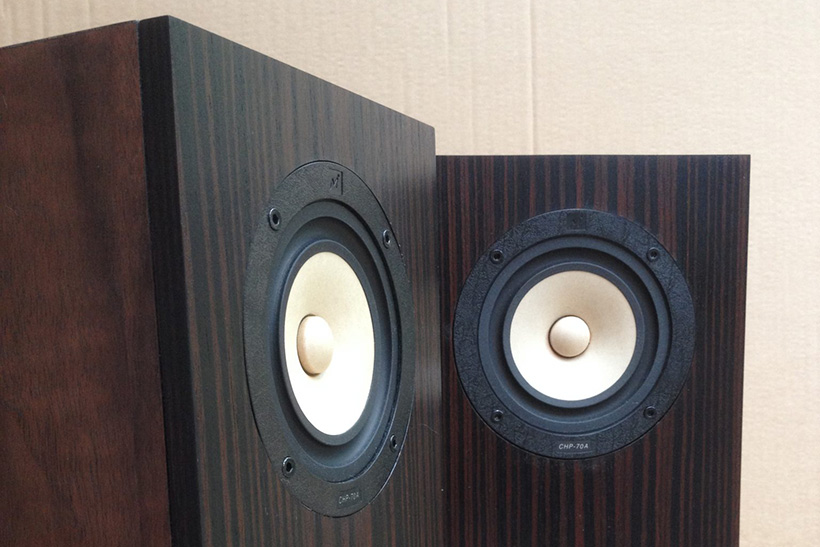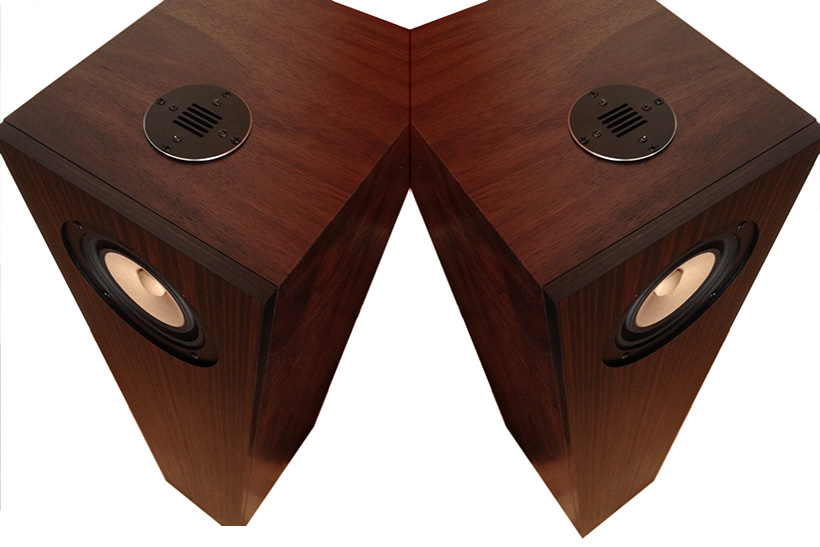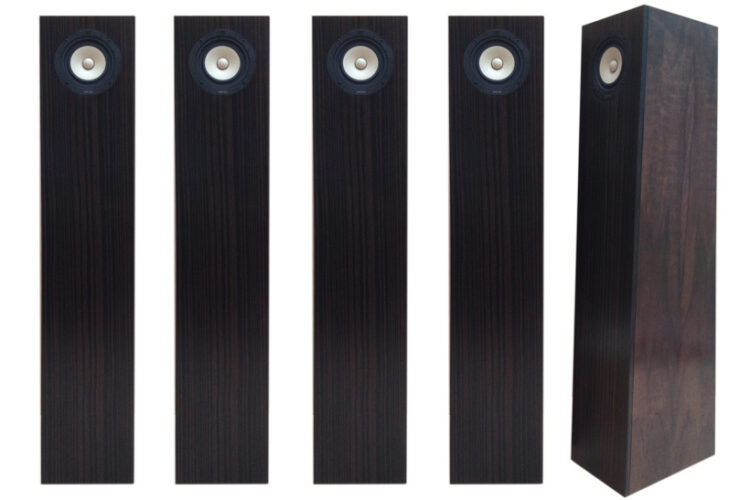Every audiophile begs, buys or borrows equipment over the period of their love affair with home music reproduction. Depending on the influence of ‘external factors’ (room size, domestic acceptance, aspiration vs available budget) the one component which tends to cause the most grief is the last one in the chain – the loudspeaker. Why? Well, initially there’s a tension between the physical size of the loudspeaker and the available space in which you’re hoping it might fit. Let’s be honest; most of us would prefer to head for larger speakers given the choice, as in general (OK, shoot me down in flames) bigger boxes tend (over-generalisation, obviously) to give an overall ‘better’ and more satisfying performance. Larger drivers will generally give better bass, dynamics will usually be wider, though some will argue imaging might suffer.
On top of this, no matter what the size of the speaker (assuming it will physically fit), whether it complements the existing décor is another major issue in a number of domestic environments. Then (and in ‘shared-use’ spaces) and only then does sound quality start to become important. There’s no point in denying that the other components in the replay chain make a difference to the end result, the sound we hear, but the final interaction is between speaker(s) and the room, and with so very many variables, this is perhaps the most critical part to get right, and also the easiest to get wrong.

I love low-powered systems, and horn speakers. Having said that, I like electrostatics too, and there are many ‘conventional’ speakers which float my boat, but when this design, originating from a 1934 horn-loading patent, here rekindled by Steve Jay at Electricbeach, caught my eye I felt this was potentially an interesting foray into an area where the seeming sum of the parts would fall short of (my) expectation. Not that I was setting it up to fail; far from it. More that a very slim, not-very-tall elegantly if uniquely styled modest box might not be able to ‘do the business’.
The business
So I coupled up my 2A3 SET valve amplifier (a Loftin-White clone) and pinned back my ears. Now, the Blackwoods have what appears to be a very small main driver. Almost too small. Even playing with two watts (on a good day, downhill with the brakes off and the wind at my back) I wasn’t expecting too much. After all, that tiny driver – I must be really careful with it in case.
But I need not have worried. As with the seventies Jordan Watts designs, these small drivers excel. Being very light the wide dispersion paper-coned drivers are particularly deft and responsive. The forward throw of the mid-to-upper reaches is fast, detailed, effortless and possibly just slightly soft. However, atop the cabinet, set almost invisibly from the sitting position, is a wondrous Kapton ribbon tweeter which fills in the uppermost reaches with an airy and sparkling ease. The join between main driver and tweeter is seamless to the ear, and despite firing upwards adds immeasurably to the musical performance, allowing the main driver to concentrate on that all-important midrange. This has the added benefit of rather than ‘firing’ the treble directly at us, this speaker has a dispersion characteristic more akin to the ‘real world’ (acoustic instruments have very broad dispersion), and conjures up a very real sense of ‘being there’. It also makes the ‘sweet spot’ for listening much wider, allowing more than one listener the delights of music at the same time.
But what of the low end? How does such a small main driver cope with deep bass? Now, I have to consider very carefully how I couch the next bit. If I wanted to play some loud reggae, perhaps some infra-bass stuff or drum’n’bass really loud I think I’d be disappointed. (I didn’t try!). But although there’s not as much weight to the very low end as having a pair of active subs it is both extended, articulate and pretty weighty.
Walls and corners
It must be said that as the horn exits at the rear, a degree of rear reinforcement is advisable. It’s not that the bass isn’t there because it is, but place the speakers too far from a rear wall or a corner and it can potentially get a bit lost. The Electricbeach website recommends placing the speakers either about 8 inches (20cm) from a rear wall, slightly toed-in or about 15 inches (38cm) from corners. As a starting point this is very sensible advice, but as noted above, every listening environment is different, and as many will know, even the same room, but with the speakers placed on a different wall will make a huge difference to the end result.

Initial listening suggested that, although man enough for ‘polite’ levels, more than 2 Watts is needed to make these elegant babies really sing. So I started to swap out various higher power amps just to see what happens. Again, as the website suggests, 15watts is the minimum really needed to make these modestly-sized speakers really come alive. Initially I headed for stalwart favourites – a pair of Quad IIs which really did give a glimpse of how much more life there is in the Blackwoods, followed by a recently restored and upgraded Quad 303. Hmmmm! This is getting to be a more and more enjoyable experience. So I coupled up a venerable Naim 250 combo, and then a pair of Audio Research Ref 210s…
One thing I learned very quickly, as I was swapping all the power amps about, was that these speakers will reveal differences between amplifiers. It’s not that they favour either solid state or valve, or sound better or worse with one or the other, but mixing and matching does make a difference to how the Blackwoods sound. That may be something to bear in mind when you try them out, but it also demonstrates how revealing these speakers are.
The only limitation I came across (well, I guess two, really, if I’m being honest), is that after a certain point, especially with a very meaty amp driving them, you do need to be a little judicious with the old volume knob. While the speakers show a very real willingness for you to ‘turn it up to 11’, reality eventually kicks in. They don’t get shouty, image doesn’t suffer but you do get the feeling that that seemingly-too-small driver is almost hitting the buffers. The second limitation is that there is a lower (or is it upper) limit to how much bass they can produce. Given good control from a suitably meaty amplifier they will produce an extraordinary amount of good, clean, deep fast bass. Classical organ music was reproduced with a startling amount of depth as well as an amazing ability to conjure up the huge spaces these recordings are usually made in. On the other hand, classical string quartet, or an intimate jazz trio / quartet was almost holographic in its presentation. There was nothing amiss in the dynamics department either, with raucous and harsh big band recordings showing all the verve and bite of live music, yet at the same time subtle female vocals and softer guitar music having a worryingly (I had to keep looking to make sure there really wasn’t someone actually in the room with me…) tactile presentation to enjoy.

The usual rules
One advantage (if that’s the right word) of the upward-firing tweeter is that the usual rules of speaker spacing seem not to apply so rigidly. Trying the speakers out on different walls in two very different listening rooms enabled me to ease them further apart than I would have normally tried. When against the longer wall somehow the soundstage stretched far wider than I expected. There was little, if any, loss of focus either. The first clue that they were too far apart was that the bass somehow felt ‘disjointed’ and ethereal rather than focussed. Apart from that, I think they should perform well in most domestic settings as the placement issues seem to be more critical regarding proximity to rear walls or corners rather than distance apart.
The other nice thing about these speakers is that, almost regardless of source (assuming a decent quality to begin with) they favoured neither analogue (and I include cassette on a decent machine, and FM here) nor digital, but had an unerring ability to make listening really enjoyable. Musically they were engaging, unfatiguing and kept dragging me back to listen. What do I mean by that? Well, imagine you’re listening away to something, and you fancy a cup of coffee. So up you get, and head off to the kitchen. Well, if these speakers are still playing and you remain in earshot I almost guarantee they’ll keep tempting you back before the kettle has boiled, before you’ve put the coffee in the cup; it’s such an enjoyable experience they won’t let you go.
So are the Blackwoods my speakers of choice? Most definitely. They do need driving reasonably well, and the advised 15watts is a sensible lower limit. Not that my 2A3 didn’t sound nice, because it did. But to get better dynamics and probably better bass a little more muscle is needed. They are not unforgiving speakers, but ‘decent in = decent out’, so don’t compromise too much on partnering equipment. Placement vis-a-vis walls and corners is a matter for experimentation to get best performance. They are not uber critical, but it’s really worth taking some time and effort to find their sweet spot – and as mentioned above, don’t be afraid to try spacing them further apart than some other speakers. You might be pleasantly surprised.
Lastly, the WAF or ‘wife acceptance factor’. The reaction from my other half was a resounding ‘I like those’ when they were first unpacked, and despite the very different décor in our two rooms, fitted well into both. Finish at present is smoked walnut veneer, treated with Osmo Poly-X oil to a rich, soft patina’. In other words they look bloody gorgeous! Main cabinet construction is birch ply, immaculately finished, and the speaker also ‘includes’ an integral decoupled plinth in the base. You can easily remove this, or refit as you prefer. It’s essentially hidden, and may make a subtle difference to the bass depending on whether you have a hard or soft floor covering.

Lastly, don’t be fooled (or put off) by thinking these have the same characteristics as the often-maligned ‘traditional’ horn designs. These are superb speakers, carefully implementing the best of horn technology – in this case a initial design concept from 1934 – in an attractive, thoroughly musical, modestly-sized package. Overall conclusion: At this price they are something of a major bargain. Their performance does have (ultimate) limitations but within the design parameters these speakers produce a musical experience which is very difficult to beat. An audition is probably a prerequisite, and certainly in the context of your own listening space if at all possible, but don’t be surprised if, when you do buy a pair, you can’t turn them off. Highly recommended.


